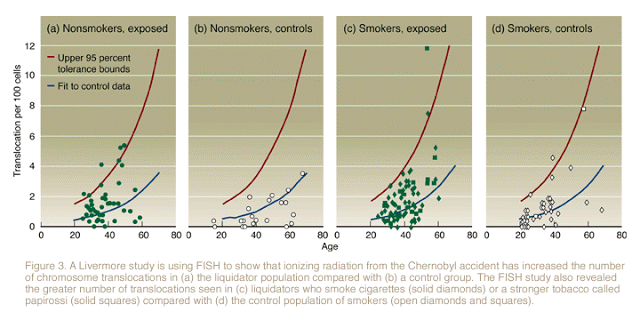Lawrence Livermore studies on Chernobyl liquidators have focused on three techniques-two of them developed at Livermore in the 1980s-that are in wide use today to monitor genetic damage in people. The techniques are called biodosimeters because they measure changes in cells to infer the biological consequences of the “dose,” or energy deposited in human tissue from ionizing radiation.
A technique called FISH (fluorescence in situ hybridization), which was developed at Livermore and is currently used around the world, has been applied to Chernobyl liquidators as well as to others suspected of receiving ionizing radiation or of being exposed to potentially damaging chemicals. FISH measures chromosome damage by detecting the number of reciprocal translocations, or broken pieces of chromosomes, in lymphocytes that rejoin in a mismatched way. Livermore scientists have shown that the number of reciprocal translocations is proportional to exposure to ionizing radiation at low doses. What’s more, unlike some biodosimeters, including other types of chromosome alterations, the frequency of reciprocal translocations is sufficiently stable with time (even over several decades) to permit retrospective dosimetry and can be measured accurately at low levels of radiation.
ON April 26, 1986, an accident at the Chernobyl nuclear reactor in the former Soviet Union released an enormous number of fission products into the atmosphere and over a large portion of the planet. With about 100 million curies released in the 10 days following the initial explosion, the accident was the largest single nonmilitary release of radioactivity in history-and one of the largest environmental disasters ever.
During the first year after the accident, about 25,000 people, mainly Soviet Army troops, were dispatched to the site to clean up the accident. These so-called liquidators were estimated to have received doses of up to 70 centigrays (a gray is the international unit for measuring absorbed ionizing radiation and is equivalent to 100 rads, or 1 joule per kilogram). In the following three years, another half-million people assisted the effort and are estimated to have received lower doses (about 10 to 25 centigrays).
The tasks performed by liquidators included shoveling core material off the roof of the undamaged part of the building, operating heavy equipment to contain contaminated soil, and building a concrete sarcophagus around the destroyed reactor. Depending upon the intensity of radiation exposure associated with their assigned task, most liquidators received radiation exposures over a period of at least several days, and in some cases over many weeks.
The cancer and death rate studies that have been conducted among samples of the recorded liquidators have shown no direct correlation between radiation exposure at Chernobyl and increased cancer or death rates. The correlation between psychological problems and the status of liquidator is more clearly drawn, although the collapse of the Soviet Union and the economic troubles in Russia, Ukraine and Belarus may also be factors for psychological stress.
The total number of deaths already attributable to Chernobyl or expected in the future over the lifetime of emergency workers and local residents in the most contaminated areas is estimated to be about 4,000. This includes some 50 emergency workers who died of acute radiation syndrome and nine children who died of thyroid cancer, and an estimated total of 3,940 deaths from radiation-induced cancer and leukemia among the 200,000 emergency workers from 1986-1987, 116,000 evacuees and 270,000 residents of the most contaminated areas (total about 600,000). These three major cohorts were subjected to higher doses of radiation amongst all the people exposed to Chernobyl radiation.
The estimated 4000 casualties may occur during the lifetime of about 600,000 people under consideration. As about quarter of them will eventually die from spontaneous cancer not caused by Chernobyl radiation, the radiation-induced increase of about 3% will be difficult to observe. However, in the most highly exposed cohorts of emergency and recovery operation workers, some increase in particular cancers (e.g., leukemia) has already been observed.
Confusion about the impact has arisen owing to the fact that thousands of people in the affected areas have died of natural causes. Also, widespread expectations of ill health and a tendency to attribute all health problems to radiation exposure have led local residents to assume that Chernobyl related fatalities were much higher than they actually were.
If you liked this article, please give it a quick review on ycombinator or StumbleUpon. Thanks

Brian Wang is a Futurist Thought Leader and a popular Science blogger with 1 million readers per month. His blog Nextbigfuture.com is ranked #1 Science News Blog. It covers many disruptive technology and trends including Space, Robotics, Artificial Intelligence, Medicine, Anti-aging Biotechnology, and Nanotechnology.
Known for identifying cutting edge technologies, he is currently a Co-Founder of a startup and fundraiser for high potential early-stage companies. He is the Head of Research for Allocations for deep technology investments and an Angel Investor at Space Angels.
A frequent speaker at corporations, he has been a TEDx speaker, a Singularity University speaker and guest at numerous interviews for radio and podcasts. He is open to public speaking and advising engagements.


